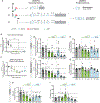Suppression of mutant C9orf72 expression by a potent mixed backbone antisense oligonucleotide
- PMID: 34949835
- PMCID: PMC8861976
- DOI: 10.1038/s41591-021-01557-6
Suppression of mutant C9orf72 expression by a potent mixed backbone antisense oligonucleotide
Abstract
Expansions of a G4C2 repeat in the C9ORF72 gene are the most common genetic cause of amyotrophic lateral sclerosis (ALS) and frontotemporal dementia (FTD), two devastating adult-onset neurodegenerative disorders. Using C9-ALS/FTD patient-derived cells and C9ORF72 BAC transgenic mice, we generated and optimized antisense oligonucleotides (ASOs) that selectively blunt expression of G4C2 repeat-containing transcripts and effectively suppress tissue levels of poly(GP) dipeptides. ASOs with reduced phosphorothioate content showed improved tolerability without sacrificing efficacy. In a single patient harboring mutant C9ORF72 with the G4C2 repeat expansion, repeated dosing by intrathecal delivery of the optimal ASO was well tolerated, leading to significant reductions in levels of cerebrospinal fluid poly(GP). This report provides insight into the effect of nucleic acid chemistry on toxicity and, to our knowledge, for the first time demonstrates the feasibility of clinical suppression of the C9ORF72 gene. Additional clinical trials will be required to demonstrate safety and efficacy of this therapy in patients with C9ORF72 gene mutations.
© 2021. The Author(s), under exclusive licence to Springer Nature America, Inc.
Conflict of interest statement
Competing Interests Statement
The authors have filed a patent related to this research. RHB is co-founder of Apic Bio.
Figures



Comment in
-
New antisense oligonucleotide therapies reach first base in ALS.Nat Med. 2022 Jan;28(1):25-27. doi: 10.1038/s41591-021-01629-7. Nat Med. 2022. PMID: 35075291 No abstract available.
References
-
- Cook C & Petrucelli L Genetic Convergence Brings Clarity to the Enigmatic Red Line in ALS. Neuron 101, 1057–1069 (2019). - PubMed
Publication types
MeSH terms
Substances
Grants and funding
LinkOut - more resources
Full Text Sources
Other Literature Sources
Molecular Biology Databases
Research Materials
Miscellaneous

